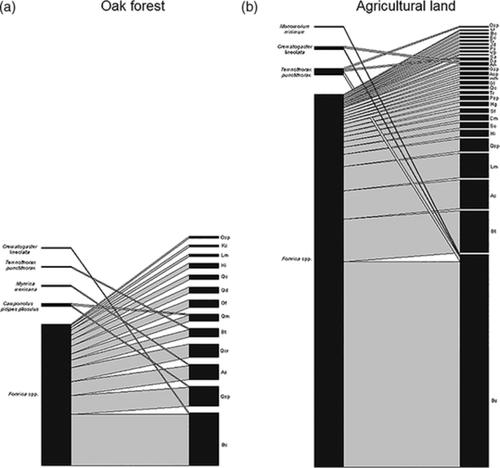当前位置:
X-MOL 学术
›
Entomol. Sci.
›
论文详情
Our official English website, www.x-mol.net, welcomes your
feedback! (Note: you will need to create a separate account there.)
Effect of agricultural land‐use change on the structure of a temperate forest ant–plant interaction network
Entomological Science ( IF 0.7 ) Pub Date : 2020-03-11 , DOI: 10.1111/ens.12407 Carlos Lara 1 , Emilia Martinez‐Bolaños 2 , Karla López‐Vázquez 1 , Cecilia Díaz‐Castelazo 3 , Citlalli Castillo‐Guevara 1 , Mariana Cuautle 4
Entomological Science ( IF 0.7 ) Pub Date : 2020-03-11 , DOI: 10.1111/ens.12407 Carlos Lara 1 , Emilia Martinez‐Bolaños 2 , Karla López‐Vázquez 1 , Cecilia Díaz‐Castelazo 3 , Citlalli Castillo‐Guevara 1 , Mariana Cuautle 4
Affiliation

|
Studies on the responses of ant–plant interactions to land‐use change have mainly focused on tropical habitats, usually without considering the impacts on the structure of interaction networks. Here we show that land‐use modifies the structure of the ant–plant interaction networks in a temperate habitat. Ant–plant interactions and plant diversity were recorded in an oak forest and agricultural land in central Mexico. We registered five ant species in the oak forest, and four ant species in the agricultural land. Plant diversity was higher in the agricultural land than in the oak forest. In the ant–plant networks of both sites, our results showed a higher dependence of ants on the plants on which they feed than vice versa, and the ants Formica spp. and the plants Barkleyanthus salicifolius were the species with the most strength and greatest influence in the network structure. The ant–plant network in the oak forest showed a nested structure. However, the network at the agricultural land site showed non‐nestedness; the identity of both ants and plants with the highest values of specialization was different and the number of ant species in the network was decreased, but the number of plant species with which they interacted significantly increased. Both ant–plant networks were equally tolerant to simulated extinction of individual species. We conclude that temperate forest ant–plant networks can be inherently fragile and susceptible to the effects of agricultural land‐use change, not on the number of interacting species but on their identity.
中文翻译:

农地利用变化对温带森林蚂蚁-植物互作网络结构的影响
蚂蚁-植物相互作用对土地利用变化响应的研究主要集中在热带栖息地,通常没有考虑对相互作用网络结构的影响。在这里,我们表明土地利用改变了温带栖息地中蚂蚁-植物相互作用网络的结构。在墨西哥中部的橡树林和农田中记录了蚂蚁与植物的相互作用和植物多样性。我们在橡树林中登记了 5 种蚂蚁,在农田登记了 4 种蚂蚁。农业用地的植物多样性高于橡树林。在两个站点的蚂蚁植物网络中,我们的结果显示蚂蚁对它们所喂养的植物的依赖性更高,反之亦然,而蚂蚁 Formica spp。植物Barkleyanthus salicifolius是网络结构中强度最大、影响最大的物种。橡树林中的蚂蚁-植物网络呈嵌套结构。然而,农业用地的网络表现出非嵌套性;具有最高特化值的蚂蚁和植物的身份不同,网络中的蚂蚁物种数量减少,但与之相互作用的植物物种数量显着增加。两种蚂蚁 - 植物网络对单个物种的模拟灭绝同样具有耐受性。我们得出的结论是,温带森林蚂蚁-植物网络本质上是脆弱的,容易受到农业土地利用变化的影响,而不是相互作用物种的数量,而是它们的特性。橡树林中的蚂蚁-植物网络呈嵌套结构。然而,农业用地的网络表现出非嵌套性;具有最高特化值的蚂蚁和植物的身份不同,网络中的蚂蚁物种数量减少,但与之相互作用的植物物种数量显着增加。两种蚂蚁 - 植物网络对单个物种的模拟灭绝同样具有耐受性。我们得出的结论是,温带森林蚂蚁-植物网络本质上是脆弱的,容易受到农业土地利用变化的影响,而不是相互作用物种的数量,而是它们的特性。橡树林中的蚂蚁-植物网络呈嵌套结构。然而,农业用地的网络表现出非嵌套性;具有最高特化值的蚂蚁和植物的身份不同,网络中的蚂蚁物种数量减少,但与之相互作用的植物物种数量显着增加。两种蚂蚁 - 植物网络对单个物种的模拟灭绝同样具有耐受性。我们得出的结论是,温带森林蚂蚁-植物网络本质上是脆弱的,容易受到农业土地利用变化的影响,而不是相互作用物种的数量,而是它们的特性。具有最高特化值的蚂蚁和植物的身份不同,网络中的蚂蚁物种数量减少,但与之相互作用的植物物种数量显着增加。两种蚂蚁 - 植物网络对单个物种的模拟灭绝同样具有耐受性。我们得出的结论是,温带森林蚂蚁-植物网络本质上是脆弱的,容易受到农业土地利用变化的影响,而不是相互作用物种的数量,而是它们的特性。具有最高特化值的蚂蚁和植物的身份不同,网络中的蚂蚁物种数量减少,但与之相互作用的植物物种数量显着增加。两种蚂蚁 - 植物网络对单个物种的模拟灭绝同样具有耐受性。我们得出的结论是,温带森林蚂蚁-植物网络本质上是脆弱的,容易受到农业土地利用变化的影响,而不是相互作用物种的数量,而是它们的特性。
更新日期:2020-03-11
中文翻译:

农地利用变化对温带森林蚂蚁-植物互作网络结构的影响
蚂蚁-植物相互作用对土地利用变化响应的研究主要集中在热带栖息地,通常没有考虑对相互作用网络结构的影响。在这里,我们表明土地利用改变了温带栖息地中蚂蚁-植物相互作用网络的结构。在墨西哥中部的橡树林和农田中记录了蚂蚁与植物的相互作用和植物多样性。我们在橡树林中登记了 5 种蚂蚁,在农田登记了 4 种蚂蚁。农业用地的植物多样性高于橡树林。在两个站点的蚂蚁植物网络中,我们的结果显示蚂蚁对它们所喂养的植物的依赖性更高,反之亦然,而蚂蚁 Formica spp。植物Barkleyanthus salicifolius是网络结构中强度最大、影响最大的物种。橡树林中的蚂蚁-植物网络呈嵌套结构。然而,农业用地的网络表现出非嵌套性;具有最高特化值的蚂蚁和植物的身份不同,网络中的蚂蚁物种数量减少,但与之相互作用的植物物种数量显着增加。两种蚂蚁 - 植物网络对单个物种的模拟灭绝同样具有耐受性。我们得出的结论是,温带森林蚂蚁-植物网络本质上是脆弱的,容易受到农业土地利用变化的影响,而不是相互作用物种的数量,而是它们的特性。橡树林中的蚂蚁-植物网络呈嵌套结构。然而,农业用地的网络表现出非嵌套性;具有最高特化值的蚂蚁和植物的身份不同,网络中的蚂蚁物种数量减少,但与之相互作用的植物物种数量显着增加。两种蚂蚁 - 植物网络对单个物种的模拟灭绝同样具有耐受性。我们得出的结论是,温带森林蚂蚁-植物网络本质上是脆弱的,容易受到农业土地利用变化的影响,而不是相互作用物种的数量,而是它们的特性。橡树林中的蚂蚁-植物网络呈嵌套结构。然而,农业用地的网络表现出非嵌套性;具有最高特化值的蚂蚁和植物的身份不同,网络中的蚂蚁物种数量减少,但与之相互作用的植物物种数量显着增加。两种蚂蚁 - 植物网络对单个物种的模拟灭绝同样具有耐受性。我们得出的结论是,温带森林蚂蚁-植物网络本质上是脆弱的,容易受到农业土地利用变化的影响,而不是相互作用物种的数量,而是它们的特性。具有最高特化值的蚂蚁和植物的身份不同,网络中的蚂蚁物种数量减少,但与之相互作用的植物物种数量显着增加。两种蚂蚁 - 植物网络对单个物种的模拟灭绝同样具有耐受性。我们得出的结论是,温带森林蚂蚁-植物网络本质上是脆弱的,容易受到农业土地利用变化的影响,而不是相互作用物种的数量,而是它们的特性。具有最高特化值的蚂蚁和植物的身份不同,网络中的蚂蚁物种数量减少,但与之相互作用的植物物种数量显着增加。两种蚂蚁 - 植物网络对单个物种的模拟灭绝同样具有耐受性。我们得出的结论是,温带森林蚂蚁-植物网络本质上是脆弱的,容易受到农业土地利用变化的影响,而不是相互作用物种的数量,而是它们的特性。











































 京公网安备 11010802027423号
京公网安备 11010802027423号